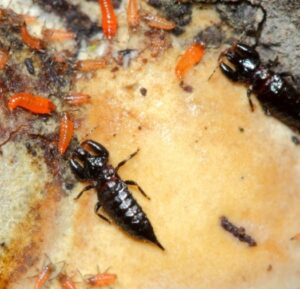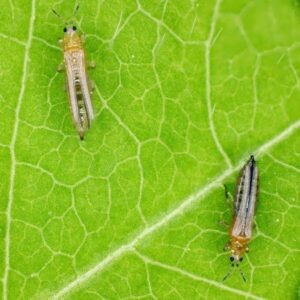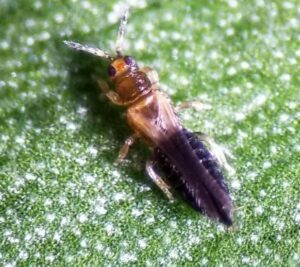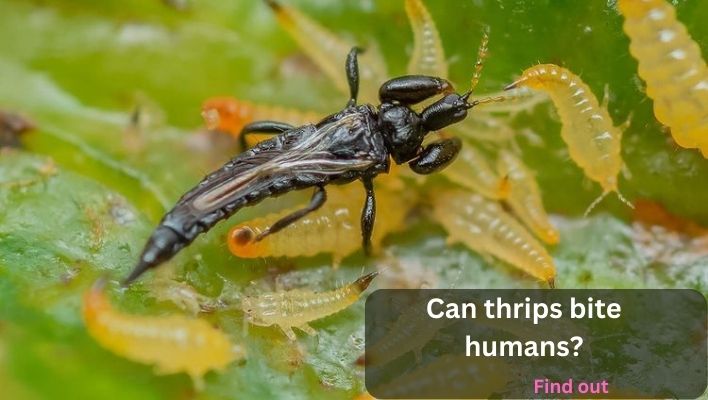Thrips are tiny, slender insects that feed on various plants and insects. They can be a nuisance due to their tendency to invade homes and cause damage to crops and ornamental plants. But what about humans? Can thrips bite humans and cause harm?
Thrips feed by piercing the plant’s surface with their mouthparts and then sucking out the sap. Can they do the same when they land on humans?
In this blog, we will explore the behavior of thrips and whether or not they are capable of biting humans. We will also discuss the potential health effects of thrips and what can be done to prevent an infestation.
Whether you’re a gardener, farmer, or just curious about these tiny pests, this post has the information you need to stay informed.
Can thrips bite humans?
Thrips are tiny, slender insects that feed on the sap of plants but can also feed on other insects. They are known for their feeding damage to crops and ornamental plants, but can they bite humans?
Yes; thrips can bite humans. While they are not known to carry diseases that harm humans, their bite can cause skin irritation, itching, and redness. Some people may experience more severe reactions to their bites, such as swelling or blistering.
Thrips may bite humans when disturbed, such as when a person is working in the garden or brushing up against plants infested with thrips.
These bites, if we can call them that, are not intended as a feeding mechanism but rather a defensive response from the thrips.
The sensation caused by thrips bite can vary from person to person. Some individuals may experience mild itching or a prickling sensation when thrips come into contact with their skin.
However, it’s important to emphasize that such reactions are relatively uncommon and generally not a cause for concern.
Furthermore, it’s worth mentioning that thrips do not transmit diseases to humans as certain other biting insects do. They primarily pose a threat to plants by damaging leaves, buds, and fruits.
So, if you notice thrips in your garden or crops, it’s essential to focus on managing their populations to prevent damage to your plants.
Are thrips harmful to humans?
First, it is important to know if thrips harm humans and take precautions seriously. Thrips are tiny insects that belong to the order Thysanoptera and are not harmful to humans.
Generally, they feed on the sap of plants and are considered pests by gardeners and farmers. While thrips are not directly harmful to humans, they can cause some indirect harm. For example, thrips can spread plant viruses that can affect the quality and yield of crops. This, in turn, can impact the food supply and cause economic losses for farmers.
Thrips can also cause skin irritation and itching when they come into contact with human skin. In severe cases, some people may develop an allergic reaction to the bites, which can cause skin redness, swelling, and itching. This can be treated with over-the-counter antihistamines or hydrocortisone creams.
However, while thrips are not harmful to humans in a direct way, they can cause indirect harm by affecting crops and causing skin irritation and indoor infestations.
Therefore, controlling thrips populations in gardens and agricultural fields is important to prevent these indirect harms. They are mainly a nuisance for gardeners and farmers and can be managed with appropriate pest control measures.
What do thrip bites feel like
Thrips bites feel like a small, sharp prick or sting. Some people might experience a mild burning or itching sensation after being bitten. The bites are usually not painful but can become uncomfortable if multiple bites are in one area.
However, it is important to note that not everyone experiences a reaction to thrips bites, as some people may have a higher tolerance or be immune to their saliva.
In most cases, the bites will cause a small red bump or welt to form on the skin, which may be itchy or painful. Some people may also develop a rash or hives around the bite site. These symptoms are usually mild and will go away within a few hours or days.
Some people can experience more severe reactions, such as anaphylaxis, which can cause swelling, itching, and redness. These symptoms are rare but should be taken seriously, and medical attention should be sought immediately if they occur.
Suppose you experience any of these symptoms after working on your farm. Cleaning the affected area and applying an antiseptic or anti-inflammatory cream to soothe the skin are recommended.
Why do thrips bite humans?
Thrips are tiny insects that feed on plants and other insects. They use sharp mouthparts to puncture the surface of leaves and other vegetation, allowing them to suck out the sap and other fluids.
While thrips are not known to bite humans, there have been instances where people have reported being bitten by these insects.
There are several reasons why thrips may bite humans. One of the most common reasons is that they are attracted to humidity, human sweat, and oils. When people are working outside in the garden or in areas where thrips are present, they may become covered in sweat and other oils. This can attract thrips, who will then land on the skin and bite to feed.
Another reason thrips may bite humans is that they seek shelter. Thrips are known to hide in dark and damp areas, and they may find their way into clothing or onto the skin of people working or spending time outdoors. In these cases, they may bite in order to find a safe and secure place to hide.
Finally, some thrips species are known to be aggressive and may bite humans if they feel threatened.

How to keep thrips from biting me
To avoid thrips bites, wearing long sleeves and pants is best when working in infested areas. Applying insect repellent can also help to deter thrips from biting. Additionally, controlling thrips populations on plants through proper pest management techniques can help to reduce the number of thrips that come into contact with humans; Here are the various ways to keep thrips from biting you.
Wear protective clothing:
Covering up with long-sleeved shirts, pants, and socks can help to prevent thrips from biting your skin. Wearing protective clothing, such as long-sleeved shirts and pants made of tightly woven materials, such as cotton or nylon, can help.
Light colors are also less attractive to thrips. Additionally, you can tuck your pants into your socks to create a physical barrier and wear gloves to protect your hands.
Use insect repellent:
Choose an insect repellent specifically designed to repel thrips, such as repellent containing DEET, Picaridin, or Oil of Lemon Eucalyptus, to your skin. These ingredients can help to repel thrips and other biting insects.
Apply the repellent to your skin, avoiding sensitive areas such as your eyes, mouth, and hands. Make sure to apply the repellent evenly and thoroughly to all exposed skin. Reapply the repellent as often as needed, especially after sweating, swimming, or if the repellent has worn off.
Keep your environment clean:
Thrips are attracted to moisture and can breed in stagnant water. Clean up any standing water around your home and keep your yard free of debris that could attract thrips. Regularly clean your plants with an insecticide soap spray to minimize the thrips population. Vacuum or sweep often to remove thrips and their eggs.
If you have indoor plants, inspect them regularly for thrips and remove any infested plants. Check windows, doors, and other entry points for gaps and cracks. Seal them to prevent thrips from entering. Keep the air conditioning system running to reduce thrips populations and keep the air dry.
Use screens:
Keep thrips out of your home by installing screens on windows and doors. Check the screens regularly for holes and repair them as needed.
Thrips are tiny pests that feed on the sap of plants and can bite humans, causing skin irritation and itching. To prevent thrips from biting you, you can use screens as a barrier between you and the pests. Here are some ways to use screens to keep thrips from biting you:
- Install window screens: This is one of the most effective ways to keep thrips from entering your home. Ensure the screens are tight-fitting and free of holes or tears to prevent thrips from getting inside.
- Use screened porches or patios: If you enjoy spending time outside, consider using a screened porch or patio. This will keep thrips from bothering you while you enjoy the fresh air.
- Use a screened tent: If you like to camp or spend time outdoors, a screened tent can be a great way to protect yourself from thrips. The screens will keep the pests out, allowing you to enjoy outdoor activities without being bitten.
- Cover outdoor furniture: Consider covering it with a screen if you have outdoor furniture. This will prevent thrips from biting you while you sit outside.
- Wear protective clothing: If you work outside in an area with thrips, wear protective clothing such as long-sleeved shirts and pants. This will provide an extra barrier between you and the pests.
Screens are an effective way to keep thrips from biting you. By installing window screens, using screened porches or patios, using a screened tent, covering outdoor furniture, and wearing protective clothing, you can enjoy your time outdoors without being bothered by thrips.

Use natural repellents:
Some natural remedies, such as essential oils like lavender or peppermint, can be used to repel thrips. Apply these oils to your skin or clothing before spending time outside.
Thrips are tiny insects that feed on plants and sometimes humans. They can cause skin irritation and redness, especially when they bite. Here are some ways to keep thrips from biting you using natural repellents:
- Essential Oils: Essential oils like lavender, lemongrass, eucalyptus, and citronella can be used as natural repellents against thrips. Apply the oil in a carrier oil like coconut or olive oil to your skin.
- Herbs: Herbs like basil, mint, and rosemary contain natural compounds that repel thrips. You can grow these herbs near your house or rub them on your skin to keep thrips at bay.
- Garlic: Garlic is a natural repellent for thrips. Crush some garlic and mix it with water. Spray the mixture on the plants in your garden to keep thrips away.
- Neem Oil: Neem oil is a natural pesticide that can be used to repel thrips. Mix neem oil with water and spray it on the plants in your garden.
- Baking Soda: Baking soda is a natural pesticide that can be used to repel thrips. Mix baking soda with water and spray it on the plants in your garden.
- Soap: Dish soap can be used as a natural repellent against thrips. Mix dish soap with water and spray it on the plants in your garden.
Using these natural repellents, you can keep thrips from biting you and keep your garden free from these pests.
Use traps:
Yellow sticky traps can be used to trap thrips. Place the traps in areas where thrips are known to be present, such as near flowers or plants.
Thrips are tiny pests that can be a nuisance, especially when they start biting humans. To keep thrips from biting you, you can use various traps. Here are some ways to use traps to keep thrips away:
- Sticky Traps: Sticky traps can be used to capture thrips that are flying in the air. You can make your own sticky traps by spreading a sticky substance on a piece of paper or cardboard. Place these traps near the infested plants or where you think thrips may be present.
- Light Traps: Thrips are attracted to light, and you can use this to your advantage. You can set up light traps that consist of a light source and a sticky surface. Thrips will be attracted to the light and get stuck on the sticky surface, thus reducing their population.
- Yellow Sticky Cards: Yellow sticky cards are another effective trap for thrips. These cards are made from yellow cardboard and are coated with a sticky substance. Thrips are attracted to yellow and will get stuck on the sticky surface. You can place these cards in your garden or near infested plants.
- Vacuum Traps: Vacuum traps can be used to trap thrips and other insects that are present in your garden. Place the vacuum trap near the infested plants and turn it on. The suction will suck in the thrips, trapping them inside the vacuum.
- Decoys: You can also use decoys to lure thrips away from you. Decoys can be made from yellow sticky tape or a yellow sticky card placed near the infested plants. Thrips will be attracted to the yellow color and stick to the decoy, reducing the number of thrips biting you.
By using these traps, you can reduce the population of thrips in your garden and keep them from biting you. Regular monitoring and replacement of the traps are essential to maintain their effectiveness.
Conclusion
Thrips are tiny insects that feed on the sap of plants. While they are not known to bite humans, they can still cause discomfort by flying into the eyes, nose, or mouth. They can also cause damage to crops and plants, leading to economic losses for farmers.
Although they can bite, they do not typically bite humans. Thrips are not known to transmit diseases to humans, and their bites are generally not harmful. However, those sensitive to insect bites may experience itching or swelling.
Thrips can be controlled through insecticides and other methods like removing affected plants, using yellow sticky traps, and planting companion crops that act as natural repellents.
To avoid thrips, it is recommended to keep gardens and outdoor areas free of excess plant material and to wear protective clothing when working in infested areas.
